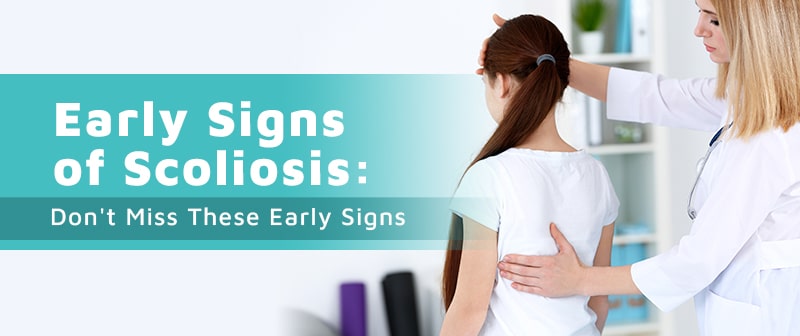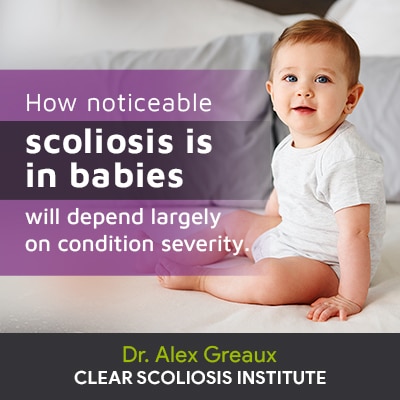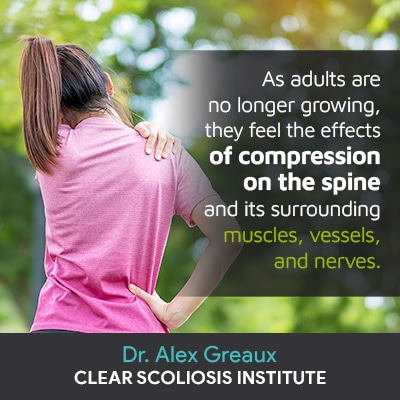
While the most prevalent form of scoliosis is adolescent idiopathic scoliosis (AIS), infants, juveniles, and adults can develop it as well. If a proactive treatment approach is applied, there are multiple benefits related to early detection. While treatment success can never be guaranteed, diagnosing and treating scoliosis early on in the condition’s progressive line can help reduce the chances of further progression.
There are different forms of scoliosis that can develop, some with known causes and some without. While different forms have different characteristics, generally speaking, the early signs of scoliosis involve postural changes related to the asymmetrical effect that scoliosis can have on the body.
Before we get into the specifics of early signs of scoliosis to watch for at different ages, let’s first address why knowing these signs is important.
If a person is diagnosed with scoliosis, this means their spine has an abnormal sideways curvature that also rotates. Scoliosis is also a progressive condition, meaning it’s in its very nature to worsen over time, especially if left untreated.
As scoliosis is progressive, it’s particularly important to know early signs of the condition to watch out for, as there are multiple benefits to early detection and starting proactive treatment as close to the time of diagnosis as possible.
Early detection isn’t always a simple thing, especially in mild forms of the condition with subtle symptoms, and especially in children and adolescents, as the condition is rarely painful; this is due to the lengthening motion that a growing spine is constantly experiencing, counteracting the compressive force of the scoliotic curve.
While there are never treatment guarantees, conditions that are diagnosed and treated in the milder stages generally involve addressing spinal curvatures that are smaller, less complex, less rigid, and before the body has had time to adjust to their presence.
There are multiple factors that go into further classifying a condition, including condition severity, which also plays a significant role in determining the type of symptoms a condition produces.
Condition severity is important because it tells us how far out of alignment a scoliotic spine is and helps guide the design of treatment plans.
Condition severity is determined by a measurement taken during X-ray known as ‘Cobb angle’. A patient’s Cobb angle places their condition on its severity scale of mild, moderate, or severe.
Mild scoliosis: Cobb angle measurement of between 10 and 25 degrees
Moderate scoliosis: Cobb angle measurement of between 25 and 40 degrees
Severe scoliosis: Cobb angle measurement of 40+ degrees
Condition severity tells us how severe a patient’s condition is and helps indicate likely rates of progression, symptoms, and potential related complications; these factors help us design a customized and effective treatment plan moving forward.
Generally speaking, the more mild a condition is, the harder it is for an average person to spot, which is, again, why knowing the condition’s early signs can be so beneficial.
As scoliosis can develop at any age, let’s start by taking a look at some of the signs of scoliosis in babies.
Early Signs of Infantile Scoliosis
When scoliosis appears in infants under the age of three, it falls under the category of ‘infantile scoliosis’.

If a baby is born with scoliosis, this is known as ‘congenital scoliosis’ and is caused by a bone malformation in the vertebrae of the spine that occurs in utero.
How noticeable scoliosis is in babies will depend largely on condition severity. Mild infantile scoliosis can produce very few noticeable signs, the most noticeable being the cosmetic appearance of the back. In addition, scoliosis is not generally painful for babies and children.
In moderate and severe cases of infantile scoliosis, the most noticeable signs to watch for involve the body’s overall posture and symmetry:
These types of postural changes are related to the uneven forces that scoliosis introduces to the body.
Early Signs of Juvenile Scoliosis
Juvenile scoliosis is diagnosed between the ages of 3 and 10 and is a form that needs the benefit of early detection.
As growth is the number-one trigger for progression, scoliosis that develops prior to that first big adolescent growth spurt is at risk of rapid-phase progression and is more likely to progress well into adulthood, if left untreated.
While in infantile scoliosis, a large number of cases resolve themselves and don’t progress, although it’s impossible to know which ones will and which won’t, this isn’t the case with juvenile scoliosis.
In addition, cases of juvenile scoliosis are more likely to progress than adolescent cases, which is why early detection is so beneficial; proactive treatment can be started to work towards impacting the condition prior to when the big trigger of growth is initiated.
The following are some early signs of juvenile scoliosis to watch for:
As juvenile scoliosis is so prone to long-term progression, this is why it should be taken seriously and treated proactively.
While adolescent idiopathic scoliosis is not as prone to long-term progression as juvenile scoliosis cases are, AIS is the condition’s most common form.
Early Signs of Adolescent Idiopathic Scoliosis
Adolescent idiopathic scoliosis is the condition’s most prevalent form diagnosed between the ages of 10 and 18.
This age group is also at risk of rapid-phase progression because they are in, or are entering into, the stage of puberty characterized by rapid and unpredictable growth spurts, and again, growth is the condition’s big trigger.
Early detection can be difficult to achieve with adolescents, as this age group isn’t known for transparency; some make efforts to conceal bodily changes out of embarrassment and/or uncertainty, not realizing that they could be early signs of a developing spinal condition.
As the condition is rarely painful, and in mild cases, the postural changes scoliosis produces can be very subtle, it’s especially helpful to know what the condition’s early signs are.
Common signs of adolescent idiopathic scoliosis involve the body’s posture and are related to the uneven force of the scoliotic curve, disrupting the body’s natural symmetry:
In addition, clothing can seem to be ill-fitting, with shirt necklines favoring one side and arms and legs seeming to hang unevenly.
When treatment is started early on in the progressive line of AIS, there are fewer limits to what we can achieve here at the CLEAR Scoliosis Institute; this is because it’s generally simpler to treat smaller curvatures while they are still small, potentially sparing patients the challenges associated with reaching the higher stages of progression.
While scoliosis is more commonly known as a child and adolescent spinal condition, adults can also develop it.
Early Signs of Adult Scoliosis

Scoliosis-related pain is most commonly felt in the back or as radiating pain into the legs and feet. As adults are no longer growing, they feel the effects of compression on the spine and its surrounding muscles, vessels, and nerves.
The two main forms of scoliosis to affect adults are idiopathic and degenerative. Idiopathic is the more common form and involves cases of AIS that were undiagnosed, untreated, and progressed into adulthood.
Had these patients been diagnosed and treated earlier, their spines would have been in better health than by the time they come to us for help. This is a perfect example of how beneficial early detection can be, as the same conditions could have been addressed and treated while the curvatures were smaller, less rigid, less complex (having not yet progressed significantly), and before the conditions became painful.
Degenerative scoliosis tends to affect adults over the age of 40. The condition develops due to natural spinal degeneration that can accompany aging (mainly the intervertebral discs) and the cumulative effect of certain negative lifestyle choices: not maintaining a healthy weight, leading a sedentary lifestyle, bad posture, and repeatedly lifting heavy objects incorrectly.
Early signs of adult scoliosis include the following:
The aforementioned visual postural symptoms of scoliosis in adults also tend to be more noticeable when in a forward-bend position.
When it comes to early detection and scoliosis, knowing the early signs of the condition to look for can increase chances of treatment success.
With certain forms, like juvenile and adolescent scoliosis, these age groups are facing a lot of significant upcoming growth, and that means a lot of potential progression; catching the condition early means starting treatment early, and being able to proactively work towards preventing the scoliosis from following its progressive nature.
Most often, the earliest signs of scoliosis involve the body’s posture and overall symmetry. As scoliosis involves uneven forces, common telltale signs of scoliosis are uneven shoulders, hips, the presence of a rib arch, and a noticeably-curved spine; in adults, pain can be one of the first signs of scoliosis.
If you, or a loved one, is concerned about scoliosis, feel free to reach out to us here at the CLEAR Scoliosis Institute where we have a dedicated team of CLEAR-certified scoliosis chiropractors waiting to help.
Clear-institute.org - Cobb Angle
Clear-institute.org - Scoliosis Screening Benefits
Clear-institute.org - Scoliosis in Adults
Scoliosis Research Society - Juvenile Scoliosis
Scoliosis Research Society - Adolescent Idiopathic Scoliosis

CLEAR provides a unique and innovative way of understanding scoliosis. Sign up to receive facts and information you won’t find anywhere else.
